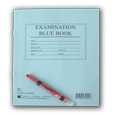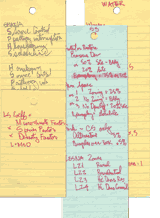These randomly scheduled missives will opine on a variety of topics, mostly intended to be germane to design, construction, capital program management, and other related issues. |
|
| May 2010 LEED  LEED®, Leadership in Energy and Environmental Design. I like to think I’m aware of and sympathetic to sustainable architecture (Green, or otherwise). Sometimes ‘good’ or ‘best’ practice is relatively obvious, and worthy of routine implementation. But, unless you knew me, and knew about my skills, I suspected that this would not be obvious. So what’s a right-thinking consultant’s best option? Well, there really only appears to be one: become a LEED Accredited Professional. The value of the credential is undeniable. A real journey. It has instigated some thought. The Exam  LEED v3 is the latest variant on the LEED accreditation and certification criteria put out by the U.S. Green Building Council (USGBC), implemented during 2009. The changes from v2 were numerous, and included many new categories of LEED Accredited Professional status. Of the five new AP options, I chose LEED AP Building Design + Construction as most relevant to my work. Before applying for the exam, however, letters confirming my involvement in previous LEED Certified projects had to be solicited and fees had to be paid. After gathering the study guides, the ordeal began in earnest. I soon realized that my rational mind and visual memory were challenged by the projected content of the exam.  Multiple practice exams demonstrated I would be forced to memorize a seemingly infinite array of reference standards and specific scorecard criteria – material easily accessed through the LEED Reference Guide for Green Building Design and Construction. Multiple practice exams demonstrated I would be forced to memorize a seemingly infinite array of reference standards and specific scorecard criteria – material easily accessed through the LEED Reference Guide for Green Building Design and Construction.To advance my preparation, I attended a USGBC workshop, purchased alternate study materials, and dedicated weeks to prepare for the exam. I thought I was smart, and this seemed just plain dumb. Finally, exam day. After removing my wallet, watch, and any writing instruments, I was next asked to turn my pockets inside out. Then I was permitted to sit for four hours at a computer terminal under the watchful eyes of TV cameras and humans. Part 1, the Green Associate exam, was a cakewalk. Part 2, The LEED AP exam, was a different matter. The computer timed out and shut me down as I was going back through uncertain answers. I’m told that the grading for the exam is ‘on a curve’, which must be why I passed, officially making me LEED AP. Anecdotal information tells me that the exam has been made progressively more difficult over the years. I hope that’s true, since this would validate my struggle. On the other hand, it appears to have been made difficult by forcing rote memorization. The real world is usually not a closed book exam. The Future of LEED Just Plain Lead?  Some assert that the popularity of LEED Certification for buildings will wane. Two factors are often cited:
Leading the way?  LEED is Good - In the way that any ‘good’ practice is ‘good’. LEED is Good - In the way that any ‘good’ practice is ‘good’.Look at the goals outlined on the home page of the USGBC web site: The U.S. Green Building Council (USGBC) is … committed to a prosperous and sustainable future for our nation through cost-efficient and energy-saving green buildings. USGBC works toward its mission of market transformation through its LEED green building certification program, robust educational offerings, a nationwide network of chapters and affiliates, … and advocacy in support of public policy that encourages and enables green buildings and communities. The LEED® green building certification program is a … rating system for buildings designed, constructed and operated for improved environmental and human health performance. LEED … emphasizes state-of-the-art strategies in five areas: sustainable site development, water savings, energy efficiency, materials and resources selection, and indoor environmental quality. LEED Professional Credentials (LEED AP and Green Associate) recognize professionals who have demonstrated a thorough understanding of green building techniques, the LEED green building rating systems, and the certification process. Unquestionably, these have been achieved in spectacular fashion; and there is serious momentum behind the endeavor. Public perception of the ‘brand’ has gained traction; and many institutions and agencies have now mandated LEED Certification for new construction. The program is a great success. The FUTURE? For LEED AP’s?  It would be nice to think that the exam will evolve into something that has more relevance to understanding sustainable design concepts. It’s unfortunate that the exam has devolved to a rite of passage for those seeking to punch the AP ticket. It would be nice to think that the exam will evolve into something that has more relevance to understanding sustainable design concepts. It’s unfortunate that the exam has devolved to a rite of passage for those seeking to punch the AP ticket.In any event, LEED v3 seems to raise the bar for professional competence; and undoubtedly, the continuing education requirements will instigate the on-going proficiency of the new AP’s (assuming, of course, that too doesn’t devolve into something lacking purpose). For LEED Certified Buildings Recently, I attended a panel discussion where a representative of a large international construction company alluded to a decreasing emphasis on ‘Green Building’. His opinion was uncontested. Perhaps it’s because the recent recession has presented more obstacles to development than LEED Certification will ever entail, or perhaps it’s because the movement has peaked, or perhaps everyone else was being polite. I suspect his observation is not yet consensus. LEED certification is still very important and particularly relevant to the industry. I don’t see it going away anytime soon, nor am I suggesting that it should. In Conclusion LEED continues to lead. It’s why I chose to become accredited, after all. But signals have arisen that bear watching, to avoid the pitfall of the program becoming leaden and burdensome. We can all retain our commitment to responsible design, construction and building management. Not receiving these newsletters in your inbox and would like to? Sign up here. Missed earlier newsletters? Find them here: |
|
